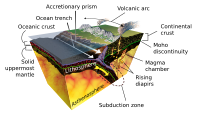
Photo from wikipedia
Abstract The Trinidad dome, Escambray complex, Cuba, forms part of an accretionary wedge built during intra-oceanic subduction in the Caribbean from the Late Cretaceous to Cenozoic. The structure reflects syn-subduction… Click to show full abstract
Abstract The Trinidad dome, Escambray complex, Cuba, forms part of an accretionary wedge built during intra-oceanic subduction in the Caribbean from the Late Cretaceous to Cenozoic. The structure reflects syn-subduction exhumation during thickening of the wedge, followed by extension. Field mapping, metamorphic and structural analysis constrain the tectonic evolution into five stages. Three ductile deformation events (D1, D2 and D3) are related to metamorphism in a compressional setting and formation of several nappes. D1 subduction fabrics are only preserved as relict S1 foliation and rootless isoclinal folds strongly overprinted by the main S2 foliation. The S2 foliation is parallel to sheared serpentinised lenses that define tectonic contacts, suggesting thrust stacks and underthrusting at mantle depths. Thrusting caused an inverted metamorphic structure with higher-grade on top of lower-grade nappes. Exhumation started during D2 when the units were incorporated into the growing accretionary wedge along NNE-directed thrust faults and was accompanied by substantial decompression and cooling. Folding and thrusting continued during D3 and marks the transition from ductile to brittle-ductile conditions at shallower crustal levels. The D4–5 events are related to extension and contributed to the final exhumation (likely as a core complex). D4 is associated with a regional spaced S4 cleavage, late open folds, and numerous extension veins, whereas D5 is recorded by normal and strike-slip faults affecting all nappes. The P-t path shows rapid exhumation during D2 and slower rates during D3 when the units were progressively incorporated into the accretionary prism. The domal shape formed in response to tectonic denudation assisted by normal faulting and erosion at the surface during the final stages of structural development. These results support tectonic models of SW subduction of the Proto-Caribbean crust under the Caribbean plate during the latest Cretaceous and provide insights into the tectonic evolution of accretionary wedges in an intra-arc setting.
Journal Title: Tectonophysics
Year Published: 2017
Link to full text (if available)
Share on Social Media: Sign Up to like & get
recommendations!